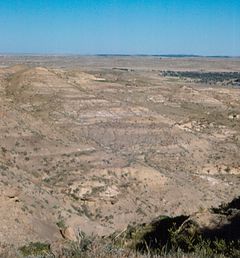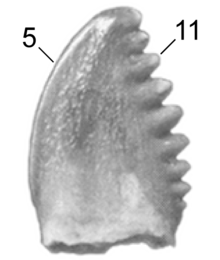Lance Formation
| Lance Formation | |
|---|---|
| Stratigraphic range: Maastrichtian, | |
 Badlands in the Lance Formation along Cow Creek near the type locality. Niobrara County, Wyoming | |
| Type | Sedimentary |
| Underlies | Fort Union Formation |
| Overlies | Meeteetse Formation |
| Thickness | up to 600 metres (1,970 ft) |
| Lithology | |
| Primary | Sandstone, siltstone, shale |
| Location | |
| Region | |
| Country | |
| Type section | |
| Named for | Lance Creek, Wyoming |
The Lance (Creek) Formation is a division of Late Cretaceous (dating to about 69 - 66 Ma) rocks in the western United States. Named after Lance Creek, Wyoming, the microvertebrate fossils and dinosaurs represent important components of the latest Mesozoic vertebrate faunas. The Lance Formation is Late Maastrichtian in age (Lancian land mammal age), and shares much fauna with the Hell Creek Formation of Montana and North Dakota, the Frenchman Formation of southwest Saskatchewan, and the lower part of the Scollard Formation of Alberta.
The Lance Formation occurs above the Baculites clinolobatus ammonite marine zone in Wyoming, the top of which has been dated to about 69 million years ago, and extends to the K-Pg boundary, 66 million years ago. However, the characteristic land vertebrate fauna of the Lancian age (which take its name from this formation) is only found in the upper strata of the Lance, roughly corresponding to the thinner equivalent formations such as the Hell Creek Formation, the base of which has been estimated at 66.8 million years old.[1]
Description
The formation is described by W.G. Pierce as thick-bedded, buff-colored sandstone, and drab to green shale. It is Upper Cretaceous in age.[2]
The formation varies in thickness from about 90m (300 feet) in North Dakota, to almost 600m (2,000 feet) in parts of Wyoming.
Depositional Environment
The Lance Formation was laid down by streams, on a coastal plain along the edge of the Western Interior Seaway. The climate was subtropical; there was no cold season and probably ample precipitation.
Paleontology
At least tens of thousands of Late Cretaceous vertebrate remains have been recovered from the Lance Formation. Fossils ranging from microscopic elements to extensive bonebeds, with nearly complete, sometimes articulated dinosaur skeletons, have been found.[3] Most other animals known from the formation are freshwater animals, and some are exclusively freshwater forms (for instance, frogs and salamanders). However, marine fossils are also found in the formation, suggesting that the sea was nearby. The bird fauna is mainly composed of orders still existing today.
Coelurosaurs
UCMP 143274 (Caenagnathidae?)[4][5]
Color key
|
Notes Uncertain or tentative taxa are in small text; |
Birds
| Birds reported from the Lance Formation | ||||||
|---|---|---|---|---|---|---|
| Genus | Species | Location | Stratigraphic Position | Material | Notes | Images |
|
A. retusus |
Reclassified as Palintropus retusus |
|||||
|
C. major |
A possible charadriiform bird | |||||
|
C. petra |
Reclassified as Lamarqueavis minima[7] | |||||
|
C. rara |
|
A charadriiform | ||||
|
C. retusa |
Reclassified as Palintropus retusus | |||||
|
C. minima |
Reclassified as Lamarqueavis minima[7] | |||||
|
"Cimolopteryx" |
"C." maxima |
|
A charadriiform bird, not necessarily closely related to Cimolopteryx.[6] | |||
|
G. augustus |
|
A possible charadriiform[8] | ||||
|
L. minima |
|
A charadriiform.[7] | ||||
|
L. petra |
|
A charadriiform.[7] | ||||
|
L. estesi |
|
A possible procellariiform[8] | ||||
|
"Lonchodytes" |
"L." pterygius |
|
A possible charadriiform.[8] | |||
|
"P." vetus |
A bird similar to gruids, idiornithids and presbyornithids.[8] | |||||
|
P. retusus |
|
A basal ornithuromorph belonging to Ambiortiformes.[9] | ||||
|
P. skutchi |
A hesperornithiform possibly also present in the Hell Creek Formation.[10] | |||||
|
T. clemensi |
|
A possible presbyornithid.[12] | ||||
|
Unnamed presbyornithid |
Indeterminate |
A presbyornithid[8] | ||||
|
Unnamed enantiornithean |
Unnamed |
|
An enantiornithean, previously referred to "Ornithomimus" minutus[13] | |||
|
Unnamed avian |
Indeterminate |
|
||||
|
Unnamed phalacrocoracid |
Indeterminate |
|
A possible phalacrocoracid.[8] | |||
|
"Unnamed ornithurine A"[6] |
Indeterminate |
Originally thought to belong to Cimolopteryx rara, but probably a new species. Also present in the Frenchman Formation.[6] | ||||
|
"Unnamed ornithurine C"[6] |
Indeterminate |
|
Also present in the Hell Creek Formation.[6] | |||
|
"Unnamed ornithurine E"[6] |
Indeterminate |
Also present in the Hell Creek Formation.[6] | ||||
|
"Unnamed ornithurine F"[6] |
Indeterminate |
Originally thought to belong to "Cimolopteryx" maxima, but probably a new species.[6] | ||||
Other Coelurosaurs
| Misc Coelurosaurs of the Lance Formation | ||||||
|---|---|---|---|---|---|---|
| Genus | Species | Location | Stratigraphic Position | Material | Notes | Images |
|
A. amplus |
Teeth, type specimen |
Dubious tyrannosaurids probably synonymous with Tyrannosaurus rex |
  | |||
|
A. cristatus |
Teeth, type specimen | |||||
|
"O." sedens |
"Sacrum and fragmentary illium"[14] type specimen |
An ornithomimid. | ||||
|
P. caperatus |
Teeth, type specimen |
A troodontid | ||||
|
P. bakkeri |
Teeth, type specimen |
|||||
|
T. rex |
Several partial specimens and teeth |
A tyrannosaurid originally identified from the Hell Creek Formation. Also found in the Denver, Ferris, Frenchman, Javelina, Livingston, McRae, North Horn, Scollard, and Willow Creek Formations. Synonyms with type specimens from this formation include Dynamosaurus imperiosus and Manospondylus gigas. | ||||
Ornithischia
Ankylosaurs
| Ankylosaurs of the Lance Formation | ||||||
|---|---|---|---|---|---|---|
| Genus | Species | Location | Stratigraphic Position | Abundance | Notes | Images |
|
A. magniventris |
An ankylosaurid, originally identified from the Hell Creek Formation. |
 | ||||
|
D. schlessmani[15] |
Skull (the type specimen) |
|||||
Marginocephalians
| Marginocephalians reported from the Lance Formation | ||||||
|---|---|---|---|---|---|---|
| Genus | Species | Location | Stratigraphic Position | Material | Notes | Images |
|
A. sylvestris |
"Partial sacrum and pelvis,"[16] type specimen. |
A dubious ceratopsid probably synonymous with Triceratops horridus |
   | |||
|
L. gracilis |
A ceratopsian | |||||
|
N. hatcheri |
"[One] skull,"[16] type specimen. |
A ceratopsid possibly synonymous with Triceratops horridus.[17] Synonyms include Diceratops hatcheri and Diceratus hatcheri. | ||||
|
P. wyomingensis |
Fragmentary specimens including the type specimen. |
A pachycephalosaur. Synonyms with type specimens from this formation include Troodon wyomingensis. | ||||
|
"Palaeoscincus" |
"P." latus |
"Tooth."[18] |
A dubious pachycephalosaur, previously classified as the ankylosaur Palaeoscincus | |||
|
S. spinifer |
A pachycephalosaur possibly synonymous with Pachycephalosaurus wyomingensis[19] | |||||
|
T. latus |
Several specimens including the type specimen. |
A ceratopsid possibly synonymous with Triceratops horridus.[17] Torosaurus gladius, with type specimen from this formation, is a synonym. Also present in the Frenchman and Hell Creek Formations. | ||||
|
T. horridus |
"Partial skull and skeleton,"[16] type specimen |
A ceratopsid, also found in the Evanston, Frenchman, Hell Creek, Laramie, and Scollard Formations. Synonyms with type specimens from this formation include T. ingens and T. sulcatus.[16] | ||||
Ornithopods
| Ornithopods of the Lance Formation | ||||||
|---|---|---|---|---|---|---|
| Genus | Species | Location | Stratigraphic Position | Abundance | Notes | Images |
|
E. annectens |
Skull, skeletons, including the type specimen and "mummy". |
A hadrosaurid. Synonyms from this formation include Anatosaurus annectens and Claosaurus annectens. Also found in the Frenchman, Hell Creek, Laramie and Scollard Formations. |
  | |||
|
T. neglectus |
Well-preserved skeleton, type specimen |
A thescelosaurid.[20] Also found in the Frenchman, Hell Creek, Laramie and Scollard Formations. | ||||
|
T. occidentalis |
Teeth, vertebrae, toe bone (including type specimen) |
A dubious hadrosaurid possibly synonymous with E. annectens | ||||
|
"Trachodon" |
"T." longiceps |
One partial jaw (YPM 616), type specimen |
A dubious hadrosaurid possibly synonymous with E. annectens | |||
Other vertebrates
Other land vertebrates include pterosaurs (e.g. cf. Azhdarcho), crocodiles, champsosaurs, lizards, snakes, turtles, frogs and salamanders.
Remains of fishes and mammals have also been found in the Lance Formation.
See also
- List of fossil sites (with link directory)
- List of dinosaur-bearing rock formations
Footnotes
- ^ Lehman, T. M., Mcdowell, F. W., & Connelly, J. N. (2006). First isotopic (U-Pb) age for the Late Cretaceous Alamosaurus vertebrate fauna of West Texas, and its significance as a link between two faunal provinces. Journal of Vertebrate Paleontology, 26(4), 922-928.
- ^ Pierce, W.G., 1997, Geologic map of the Cody 1 degree x 2 degrees quadrangle, northwestern Wyoming: U.S. Geological Survey, Miscellaneous Geologic Investigations Map I-2500, scale 1:250000.
- ^ Silver, Mark (August 2, 2014) "The Dinosaur Surveyors" The American Surveyor Frederick Maryland
- ^ Stidham, 1998
- ^ Dyke, GJ; Mayr, G. (1999). "Did parrots exist in the Cretaceous period?". Nature 399 (6734): 317–318. doi:10.1038/20583.
- ^ a b c d e f g h i j k l m n o p q r s t Nicholas R. Longrich (2011). "Titanoceratops ouranous, a giant horned dinosaur from the Late Campanian of New Mexico". Cretaceous Research. 32. doi:10.1016/j.cretres.2010.12.007.
- ^ a b c d e f Federico L. Agnolin (2010). "An avian coracoid from the Upper Cretaceous of Patagonia, Argentina". Stvdia Geologica Salmanticensia. 46 (2): 99–119.
- ^ a b c d e f g h i j k l m n o p q r Hope, 2002
- ^ a b Longrich, N. 2009. An ornithurine-dominated avifauna from the Belly River Group (Campanian, Upper Cretaceous) of Alberta, Canada. Cretaceous Research, 30(1): 161-177.
- ^ a b c Elzanowski, Paul and Stidham, 2001. An avian quadrate from the Late Cretaceous Lance Formation of Wyoming. Journal of Vertebrate Paleontology, 20(4): 712-719.
- ^ "Table 11.1," in Weishampel, et al. (2004). Page 215.
- ^ a b Olson, S.L. and Feduccia, A. 1980. Presbyornis and the origin of the Anseriformes (Aves: Charadriomorphae). Smithsonian Contributions to Paleobiology no. 323.
- ^ a b Chiappe, L. M., and Walker, C. A. (2002) Skeletal morphology and systematics of the Cretaceous Euenantiornithes (Ornithothoraces: Enantiornithes): In: Mesozoic Birds, above the heads of Dinosaurs, University of California Press, 240-267.
- ^ "Table 6.1," in Weishampel, et al. (2004). Page 139.
- ^ Bakker, R.T. (1988). Review of the Late Cretaceous nodosauroid Dinosauria: Denversaurus schlessmani, a new armor-plated dinosaur from the Latest Cretaceous of South Dakota, the last survivor of the nodosaurians, with comments on Stegosaur-Nodosaur relationships. Hunteria 1(3):1-23.(1988).
- ^ a b c d "Table 23.1," in Weishampel, et al. (2004). Page 496.
- ^ a b Scannella, J. and Horner, J.R. (2010). "Torosaurus Marsh, 1891, is Triceratops Marsh, 1889 (Ceratopsidae: Chasmosaurinae): synonymy through ontogeny." Journal of Vertebrate Paleontology, 30(4): 1157 - 1168. doi:10.1080/02724634.2010.483632
- ^ "Table 17.1," in Weishampel, et al. (2004). Page 368.
- ^ Horner J.R. and Goodwin, M.B. (2009). "Extreme cranial ontogeny in the Upper Cretaceous Dinosaur Pachycephalosaurus." PLoS ONE, 4(10): e7626. Online full text
- ^ Boyd, Clint A.; Brown, Caleb M.; Scheetz, Rodney D.; Clarke, Julia A. (2009). "Taxonomic revision of the basal neornithischian taxa Thescelosaurus and Bugenasaura". Journal of Vertebrate Paleontology. 29 (3): 758–770. doi:10.1671/039.029.0328.
